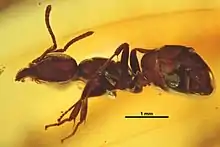Ctenobethylus
Ctenobethylus is an extinct genus of ants in the subfamily Dolichoderinae. The genus contains a single described species Ctenobethylus goepperti, where the fossil is known to be from the Baltic Amber.[1] The fossil contained a preserved mesostigmatid mite attached to the head of the ant, which is perhaps the oldest known evidence of ecological association between mites and ants.[2]
| Ctenobethylus Temporal range: Baltic amber | |
|---|---|
 | |
| Scientific classification | |
| Domain: | Eukaryota |
| Kingdom: | Animalia |
| Phylum: | Arthropoda |
| Class: | Insecta |
| Order: | Hymenoptera |
| Family: | Formicidae |
| Subfamily: | Dolichoderinae |
| Tribe: | Tapinomini |
| Genus: | †Ctenobethylus Brues, 1939 |
| Species: | †C. goepperti |
| Binomial name | |
| †Ctenobethylus goepperti (Mayr, 1868) | |
| Synonyms | |
| |
References
- Bolton, Barry (June 1994). Identification Guide to the Ant Genera of the World (1st ed.). Cambridge, Massachusetts: Harvard University Press. p. 26. ISBN 0674442806.
- Dunlop, J. A.; Kontschan, J.; Walter, D. E.; Perrichot, V. (10 September 2014). "An ant-associated mesostigmatid mite in Baltic amber". Biology Letters. 10 (9): 20140531. doi:10.1098/rsbl.2014.0531. PMC 4190962. PMID 25209198.
This article is issued from Wikipedia. The text is licensed under Creative Commons - Attribution - Sharealike. Additional terms may apply for the media files.